This time we did a better homework considering our last year’s experience in Garhwal Himalayas. Iswari Bhatt of Ransi told us to opt for the first fortnight of September while trekking into deeper zones in Kedarkhand. Like his famous father, he has considerable experience as a guide and he said, “Monsoon takes a brief pause during this time till we have Rakeswari Devi’s Mela and it returns fiercely before final departure. Since last a few years, September end has been pretty devastating!”
Our trek plans for this year have traversed a curious path through days and nights of events. We thought of Satopanth Tal trek in May-June, but could not get leave. I got leave only in end June, thus opted for a family trip to North Himachal. Again, we started considering Satopanth in September. But, our friend, David (a renowned climber, Dilip Naskar) opined that water would be a serious problem in that route during monsoon end. So we switched over to Kedartal plan. The tickets were booked with options open. It went on well until early August when we started thinking about Nandikund again. It has been a rarely visited trail from trekkers’ counts. We searched for further information and snaps on net, and sadly found only one travelogue and a single snap. The image was uploaded by our Orkut friend, Rajib Ghose. Rajib gave us lots of info about the route. We know several guides in Ransi village, the place where numerous treks to Mandani-Youngbook-Mahapanth-Kedar, Kachni-Sujal Sarovar-Panpatia, Bantoli-Bisarital, Kachni-Pandosera-Nandikund-Gia Vinayak-Kalpeswar/Rudranath, etc originate from. On getting encouragements from Rajib, we started working out with Nandikund plan again. People of Ransi know Rajib like their own Garhwali men. They described him as “the man with a big sack and a telecamera with feet of a mountain goat” and they love and respect him too much. Thus, by the end of August, we were all set for Nandikund.
Umed Singh Rana, an ever-smiling man in his mid-thirties, was introduced to me by Chinmoy Chakraborty. He is my service colleague, an old family friend, presently posted as the General Manager of West Bengal Tourism Development Corporation and has been pretty famous in travelling circle for his numerous travel-books and regular contributions to different Bengali travel magazines (his Orkut name is Charnik Chinmoy and has a fantastic blog). Umed also work for Government’s field information collector and he knows lots about medicinal plants and wildlife. We talked to Umed Rana about our entire plan. He knows the places with finest details. I told him to arrange porters according to his choice and I loved to always hear his only sentence : Aap chinta maat karo, Saab; hum 7 tarikh Ukhimath me aapka integar karenge. { Contact Number of Umed Singh Rana : +919411737835}
Back to back trip always invites much pressure in office atmosphere for those who either own or don’t. So both for me and my wife and trek partner, Lopamudra, who is the boss of her own business, pre-trek weeks were flowed away in moments of strains touching the young’s modulus. Finally, we were relieved when we had safely reached with all long luggage minutes before the train whistled.
It had been a long 35 hours journey before we landed at Haridwar station at 7.45 am on 7th September. Out of suffocating environment of long cooling hours, we breathed some fresh air and rushed to Jhala Bus stand straight to catch 10 am Ukhimath Bus. We had no time to meet friends; just booked the tickets, dumped our luggage in box and went to Bilkeswar Mahadev temple for pujas.
The bus started before time, but reached Ukhimath a bit late in the evening. We saw Umed’s smiling face. Journey had taken toll on us. A sense of moving continued to stir up within even when our fatigued bodies had comfortably settled in hotel beds.
Beforehand we checked 15 days’ weather forecast and it predicted bright sunny days for most of the time with chances of cloudy weather since 18th. So, we were happy to see the morning welcoming us with a scenic blue sky with few white clouds gently floating in leisurely manner. Umed came with another boy, Dinesh Singh Rawat, who would be one of our porters. Dinesh, who looks younger than his professed 26 years of age, belonged to the family of priests of Rakeswari temple in Ransi. He is a fantastic boy with pre-graduation education works as an electrician in Ukhimath. His simpleton countenance immediately drives anyone to love him and his decent humour will make anyone to burst into wide laughter.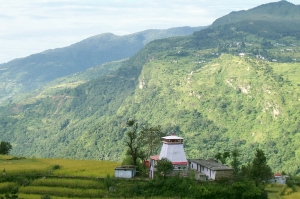 With new companions we walked along the metalled road from Ukhimath market towards Bholewar Mahadev temple down near Ukhimath-Chopta-Badrinath road. After offering pujas, we sped to market again; bought our ration and finally boarded in 11 am bus to Uniana.
With new companions we walked along the metalled road from Ukhimath market towards Bholewar Mahadev temple down near Ukhimath-Chopta-Badrinath road. After offering pujas, we sped to market again; bought our ration and finally boarded in 11 am bus to Uniana.
We reached Uniana at around 12.10 pm. It was a pretty hot noon, still we enjoyed walking with sacks and all for a shorter curvilinear path to Ransi. It was just 3 km, and we were sipping hot coffee at Umed’s place behind Rakeswari temple by 2 pm. We heard lots about Janki Bhatt (Iswari’s father) and Shibraj Singh Pawar, who were trusted commandants of legendary Umaprasad. 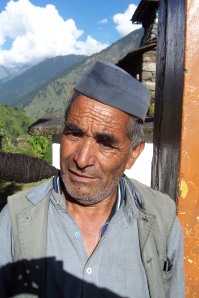 Both were famous guides associated with so many renowned trekkers. It was our luck that Shibraj Singh popped in Umed’s house. We talked for hours together. He shared his long fifty years of experiences. He encouraged us but also cautioned to take care while crossing Dwari gad.
Both were famous guides associated with so many renowned trekkers. It was our luck that Shibraj Singh popped in Umed’s house. We talked for hours together. He shared his long fifty years of experiences. He encouraged us but also cautioned to take care while crossing Dwari gad.
In the evening, another porter came to join us. Umed Singh Negi is a shepherd by profession and quite well-to-do with few hundred sheep under flock. With a stout figure even at 50, Umed Negi still spends 3-4 months in upper vales and meadows during May to August. Perhaps, he knows every rocks and streams in those areas. Together packed all essential items, chalked out final sketch to trek. We had ample time from 9th to 19th for Ransi to Ransi trek. We decided to keep it gentle on the first two days considering Lopa’s pace and would speed up in the following days. We tentatively planned to move to Madmaheswar(16 kms) on 9th, then to Kachin Dhar (9 kms) on 10th, Dwari gad (6 kms) on 11th, Pandosera (5 kms) on 12th, to Nandikund and back to Pandosera ( 12 kms) on 13th, Dwari Dhar or Pavan Dwar ( 6/7 kms) on 14th, Kachni Dhar or Nanda Berari (5/7 kms) on 15th, Madmaheswar (9/7 kms) on 16th and visit Buda Madmaheswar and then back to Ransi (19 kms) on 17th. Two additional days were kept to meet up emergency halts.
After morning pujas, we decided to move on with Dinesh while Umed Rana, our guide, and the other porter, Umed Singh Negi, would follow us with ration, utensils, tents etc. 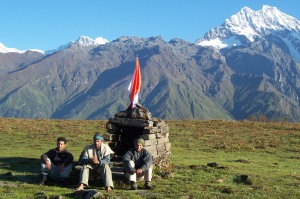 Construction of a new wide road to Goundar had extensively damaged the lower old narrow path with boulders and mud heaped all over it. We safely crossed those few miles. Weather was fine. Occasional cool breeze from Madmaheswar ganga were wiping drops of sweats on our foreheads. I always love this stretch for reasons unknown. Gently we reached Gaundar by 10 am. Up to this place, there had not been many ups and downs except while crossing the bridge near Bhima falls. After a while, our fellow men also reached to make our team a “Five men army”. We had some snacks and tea there. Without wasting further time, we decided move on. There would be steep climb all along from Bantoli to Madmaheswar (10 kms). Bantoli is a fantastic place that stands with an idyllic posture facing confluence of Markandey ganga and Madmaheswar ganga. Under the torrid sun, climbing along an average 60-65 degree gradient is always tough even when there is a distinct path. It was around 1.30 pm when we reached Nanu. We halted there for an hour to take our lunch. And, finally reached Madmaheswar by 4.30 pm. The night was starry with the moon spreading wings of its crescent wider towards the Full Moon on the 14th. We spent lovely hours outside till 11 pm before entering into deep sleep.
Construction of a new wide road to Goundar had extensively damaged the lower old narrow path with boulders and mud heaped all over it. We safely crossed those few miles. Weather was fine. Occasional cool breeze from Madmaheswar ganga were wiping drops of sweats on our foreheads. I always love this stretch for reasons unknown. Gently we reached Gaundar by 10 am. Up to this place, there had not been many ups and downs except while crossing the bridge near Bhima falls. After a while, our fellow men also reached to make our team a “Five men army”. We had some snacks and tea there. Without wasting further time, we decided move on. There would be steep climb all along from Bantoli to Madmaheswar (10 kms). Bantoli is a fantastic place that stands with an idyllic posture facing confluence of Markandey ganga and Madmaheswar ganga. Under the torrid sun, climbing along an average 60-65 degree gradient is always tough even when there is a distinct path. It was around 1.30 pm when we reached Nanu. We halted there for an hour to take our lunch. And, finally reached Madmaheswar by 4.30 pm. The night was starry with the moon spreading wings of its crescent wider towards the Full Moon on the 14th. We spent lovely hours outside till 11 pm before entering into deep sleep.
Madmaheswar to Kachni is around 8 kms. Locals frequently trekked up to Kachni to bring Brahmakamal, the sacred flower, for the Lord’s pujas. We would move a km ahead of the valley where Brahmakamal flourished abundantly. Its strong scent would intoxicate people and spending much time in the valley would make one even faint. We started early at 7 in the morning for the stretch being of pretty steep climb. For the first 4-5 kms, there was a distinct trail through jungle. Up and up, one could see Madmaheswar valley and Buda Madmaheswar top getting farther and farther. Once the tree-line ended, a rough terrain welcomed us with boulders and rocky walls. We could now see the Kachni Top, 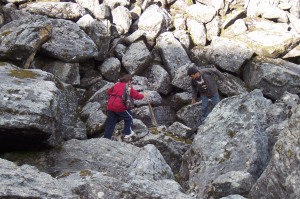 a wall like ridge with two dangerously positioned giant rocks accompanying. We met some locals on the way. They were enjoying photo-session amidst a fascinating natural garden of Poison flowers. Those alluring blue flowers have tremendous potentiality to end all lovelier smiles of living. Locals call them “Mitha Jahar” (Sweet poision)—maybe, someone tasted it sweet and died after telling its taste. We decided to have our lunch at Nanda Berari where water could be available in a pool. Post-lunch walk usually slowed up and when we reached Kachni top, it was already 3.30 pm. This place can be seen even from Uniana or Ransi. It was top of the ridge with both sides sloping steadily. From this place trekking routes bifurcate into one leading towards Kachni tal—Sujal Sarovar—Panpatia col and another towards Pandosera—Nandikund—Kalpeswar/Rudranath. We would follow the latter. The descent was difficult—firstly through long grassy meadow of around 70-75 degree slope and then through boulder zone. We safely crossed and finally set up our tents at Kachni Dhar at around 5.00 pm. The place was surprisingly calm with only occasional calls of snow pigeons. We found some peculiar rodents running and jumping around. People would call them “Bina muchka chuha” (moustache-less rodent); but, Umed informed us that they were Pica, a species of rabbit, on which Lopa was too inquisitive about bears and leopards. While cooking was on, we chatted over those frightening experiences of shepherd Umed. We spent long hours in such an ethereal atmosphere while stars and the moons showered warm glow all over. Afar we gazed at Nandikund peak with its fine crest and a beautifully saddled glacial patch within. Despite severe cold, we went to sleep much later for not to lose a moment of that dreamy sequence.
a wall like ridge with two dangerously positioned giant rocks accompanying. We met some locals on the way. They were enjoying photo-session amidst a fascinating natural garden of Poison flowers. Those alluring blue flowers have tremendous potentiality to end all lovelier smiles of living. Locals call them “Mitha Jahar” (Sweet poision)—maybe, someone tasted it sweet and died after telling its taste. We decided to have our lunch at Nanda Berari where water could be available in a pool. Post-lunch walk usually slowed up and when we reached Kachni top, it was already 3.30 pm. This place can be seen even from Uniana or Ransi. It was top of the ridge with both sides sloping steadily. From this place trekking routes bifurcate into one leading towards Kachni tal—Sujal Sarovar—Panpatia col and another towards Pandosera—Nandikund—Kalpeswar/Rudranath. We would follow the latter. The descent was difficult—firstly through long grassy meadow of around 70-75 degree slope and then through boulder zone. We safely crossed and finally set up our tents at Kachni Dhar at around 5.00 pm. The place was surprisingly calm with only occasional calls of snow pigeons. We found some peculiar rodents running and jumping around. People would call them “Bina muchka chuha” (moustache-less rodent); but, Umed informed us that they were Pica, a species of rabbit, on which Lopa was too inquisitive about bears and leopards. While cooking was on, we chatted over those frightening experiences of shepherd Umed. We spent long hours in such an ethereal atmosphere while stars and the moons showered warm glow all over. Afar we gazed at Nandikund peak with its fine crest and a beautifully saddled glacial patch within. Despite severe cold, we went to sleep much later for not to lose a moment of that dreamy sequence.
The morning was as usually bright. It would take some time to dry up tents soaked in overnight dews that had transformed into small droplets of frost. 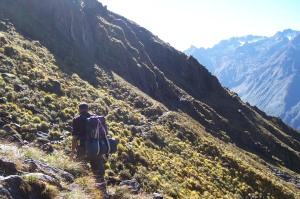 Umed, our guide, cautioned that the day’s trek would be all through boulder zones with crossing of three rivers, the last being quite tough. The distance would not be much, but would definitely invite challenging five ridges in between. So we decided to start with porters and guide following. Entire stretch was full of steep descents and ascents through boulder zones. Loose grabbles before and after small and wide streams were taking out confidence. Before we could tread a couple of miles, our friends caught us up. It was absolutely necessary too for Lopa had to aided with. We decided not to hold time for breakfast, instead we took some snacks and moved on. Finally, at around noon, we reached Pavan Dwar. It was top of a ridge with spine-chilling view of its eastern slope that met in gushing Dwari gad. Dwari gad is also known as Madgally Nala, coming straight from Panpatia glacier. We paused for a few minutes. I thought that wasting further time would let fear creep into mind to shatter confidence that needed to cross this part. So, I asked Umed to set for. Umed was in front strongly holding Lopa’s hand. We followed him with all caution. There was not a clear trail. I could only see a wide patch of loose grabbles sporadically adorn with large boulders and the slant varying from 65 to 80 degrees. After an hour of tough trek, we landed in a seemingly flat space of around 20X20 mts by a small brook. Umed showed us two paths—one straight 80 degree slipper down to the river and another around 200 mts of walling along a 3-4 inches track
Umed, our guide, cautioned that the day’s trek would be all through boulder zones with crossing of three rivers, the last being quite tough. The distance would not be much, but would definitely invite challenging five ridges in between. So we decided to start with porters and guide following. Entire stretch was full of steep descents and ascents through boulder zones. Loose grabbles before and after small and wide streams were taking out confidence. Before we could tread a couple of miles, our friends caught us up. It was absolutely necessary too for Lopa had to aided with. We decided not to hold time for breakfast, instead we took some snacks and moved on. Finally, at around noon, we reached Pavan Dwar. It was top of a ridge with spine-chilling view of its eastern slope that met in gushing Dwari gad. Dwari gad is also known as Madgally Nala, coming straight from Panpatia glacier. We paused for a few minutes. I thought that wasting further time would let fear creep into mind to shatter confidence that needed to cross this part. So, I asked Umed to set for. Umed was in front strongly holding Lopa’s hand. We followed him with all caution. There was not a clear trail. I could only see a wide patch of loose grabbles sporadically adorn with large boulders and the slant varying from 65 to 80 degrees. After an hour of tough trek, we landed in a seemingly flat space of around 20X20 mts by a small brook. Umed showed us two paths—one straight 80 degree slipper down to the river and another around 200 mts of walling along a 3-4 inches track  and then a descent of around 300 mts. Both the porters and guide advised for taking the latter one for descent and the former one for ascent when we would be returning. I accepted it as it was evident that there would be chance of rolling on even for regular trekkers in that slipper. I advised Lopa to be cautious about steps along that 3-4 inches track; softly said, “Hold Umed’s hand with your right, use the left to hold grassroots or rocky edges and never shuffle steps until you reach wider area”. One fantastic thing that Lopa possesses is she never does anything beyond what is told. Another thing I always know that she has tremendous mental strength that compensates whatever physical deficiencies. We breathed long and started. It was a treacherous track along a straight rocky wall hanging 300 mts above the river and every step would be important. It took us more than half an hour to cross it. Now, it would be another challenge to get down along rocky patch of another 300 mts height. When we finally jumped down from a 10 ft boulder, we yelled in joy of making it. But, soon our laughter evaporated when we faced the next course of crossing Dwari gad. It was around 30-40 feet wide with knee-deep water. I tossed a small stick and it vanished with lightening speed. As if I was facing a dam whose gates had all set open to lease out flood water. Crossing of rivers in afternoon is always difficult. Still, I have never seen such a gusty river before. We had no ropes to fix. Umed Rana and Umed Negi surveyed it, crossed it twice and more to identify rocks with less slippery faces. Finally, we attempted, one by one, to cross it. It took us more than an hour to finally reach the other side. Again, a frightening climb; but, the track was a bit wider here with around 6-8 inches span and rocks had more grasses on it for holding them safe and firm. Reaching over the ridge on the other side, we felt intense hunger. It was almost 3 pm. We had some quickly cooked Khichri. Another km was still left. The weather seemed cloudy also. We sped up; climbing steadily to reach the spot where tents could be set up. Umed went to bring water from Dwari river again. Clouds had spread all over and mists surrounded the world. Umed returned and together we crowded in the cave facing our set tents. It would be our kitchen for the night. Sipping over a hot mug of coffee, I lit up a strong fag that instantly wiped out strains of the past and warmly welcomed the present. It started drizzling. Umed Negi had collected fire woods. Cooking and heating up were jumbled into oneness and we went on chatting, laughing and enjoying every moments of togetherness, in so distant a place—away from luminance of civilised societies—yet thriving with passion and warmth!
and then a descent of around 300 mts. Both the porters and guide advised for taking the latter one for descent and the former one for ascent when we would be returning. I accepted it as it was evident that there would be chance of rolling on even for regular trekkers in that slipper. I advised Lopa to be cautious about steps along that 3-4 inches track; softly said, “Hold Umed’s hand with your right, use the left to hold grassroots or rocky edges and never shuffle steps until you reach wider area”. One fantastic thing that Lopa possesses is she never does anything beyond what is told. Another thing I always know that she has tremendous mental strength that compensates whatever physical deficiencies. We breathed long and started. It was a treacherous track along a straight rocky wall hanging 300 mts above the river and every step would be important. It took us more than half an hour to cross it. Now, it would be another challenge to get down along rocky patch of another 300 mts height. When we finally jumped down from a 10 ft boulder, we yelled in joy of making it. But, soon our laughter evaporated when we faced the next course of crossing Dwari gad. It was around 30-40 feet wide with knee-deep water. I tossed a small stick and it vanished with lightening speed. As if I was facing a dam whose gates had all set open to lease out flood water. Crossing of rivers in afternoon is always difficult. Still, I have never seen such a gusty river before. We had no ropes to fix. Umed Rana and Umed Negi surveyed it, crossed it twice and more to identify rocks with less slippery faces. Finally, we attempted, one by one, to cross it. It took us more than an hour to finally reach the other side. Again, a frightening climb; but, the track was a bit wider here with around 6-8 inches span and rocks had more grasses on it for holding them safe and firm. Reaching over the ridge on the other side, we felt intense hunger. It was almost 3 pm. We had some quickly cooked Khichri. Another km was still left. The weather seemed cloudy also. We sped up; climbing steadily to reach the spot where tents could be set up. Umed went to bring water from Dwari river again. Clouds had spread all over and mists surrounded the world. Umed returned and together we crowded in the cave facing our set tents. It would be our kitchen for the night. Sipping over a hot mug of coffee, I lit up a strong fag that instantly wiped out strains of the past and warmly welcomed the present. It started drizzling. Umed Negi had collected fire woods. Cooking and heating up were jumbled into oneness and we went on chatting, laughing and enjoying every moments of togetherness, in so distant a place—away from luminance of civilised societies—yet thriving with passion and warmth!
The morning was bright. We could see Pandosera valley straight from this top. We could also see what we had crossed the last day. The journey from Dwari to Pandosera would be much easier and shorter. We had kept it so for keeping body fit for next day’s long and strenuous trek to Nandikund and back. The tents were still wet. We decided to start a bit late. After breakfast at around 9 am, we began our day’s trek. The first 3 kms would be through boulder zones, but not much of steep ascent or descent. Pandosera valley started thereafter. It was a fascinatingly wide meadow with myriad flowers and medicinal herbs. Umed introduced us with names of every plant and flowers, their scientific names and how that particular area featured in record books for having natural soil still unaffected with global warming. He showed us some plants that could only exist where virginity of soil had remained intact. 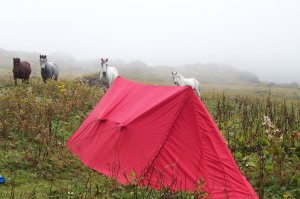 We slowly walked past the Pandav Khuli, which was a giant rock amidst the vast meadow and could be seen distinctly from Ransi. We found a decent cave near Kshetrapalji’s rock (the rock worshiped as Kshetrapal’s temple). We set up our tents there. As soon as we had reached, a troop of five stallions hurried ran towards us and gazed at us with wide innocent eyes. They were wild till May, and tamed and were left here by their master to gain weight. His time of arrival was due; and probably, those innocuous eyes wished to search for it. They stood around for long hours.
We slowly walked past the Pandav Khuli, which was a giant rock amidst the vast meadow and could be seen distinctly from Ransi. We found a decent cave near Kshetrapalji’s rock (the rock worshiped as Kshetrapal’s temple). We set up our tents there. As soon as we had reached, a troop of five stallions hurried ran towards us and gazed at us with wide innocent eyes. They were wild till May, and tamed and were left here by their master to gain weight. His time of arrival was due; and probably, those innocuous eyes wished to search for it. They stood around for long hours.
Pandosera has mythological connection with the Pandavas the great. People believe that they stayed here for long years, transformed it into a cultivable land, and dug canals, pools. It was fascinating to see well-cultivated field, a stone-made plough, clearly evident of human efforts in neatly dug canals and pools for cultivation and water storage purposes.  Believing or not of those as work of the Pandavas was not important, but we could never believe that those were not man-made. The field had a fine breed of paddy and Indrajab (the sacred plant used in Jagna) were abundant. The eastern face of the valley had some giant shields of mountains. From its north-eastern corner, a small stream flew down from glacial pool that met with wider Nandikund ganga coming down from Nandikund side on the south-eastern ranges. On every Side mountains had steep rise straight from the meadow finely ornamented with numerous brooks and streams. Pandosera had also fame for wild Himalayan bear. The evening mist had, by that time, spread and a strong wind from the northern side brought down temperature quickly. We all jammed up inside the cave to have warmth of hot flame. Not much later than when we had finished our dinner, it started raining. I had slept for a couple of hours (my usual schedule in high altitude) and by midnight, I had woken up. I wished to sit outside and smoke, but it was still raining. Lying idly I was enjoying musical tunes of rain over the tent outer. Somehow, I sensed something was moving outside. Initially I thought that those horses would be it. But, on further hearing the sounds of footsteps, I was sure that it would be a bear. I thought of turning my powerful torch on, but relented on thinking that it might infuriate the wilder one. I kept on sensing its presence till Lopa gave me a nudge. She was too afraid to speak out. I could only hear her whispering words: A bear—I felt its hot breath—it touched our tent. I did not make any comment to further make her panicky. After a while, it faded. She slept quietly for the rest of the night holding my hand.
Believing or not of those as work of the Pandavas was not important, but we could never believe that those were not man-made. The field had a fine breed of paddy and Indrajab (the sacred plant used in Jagna) were abundant. The eastern face of the valley had some giant shields of mountains. From its north-eastern corner, a small stream flew down from glacial pool that met with wider Nandikund ganga coming down from Nandikund side on the south-eastern ranges. On every Side mountains had steep rise straight from the meadow finely ornamented with numerous brooks and streams. Pandosera had also fame for wild Himalayan bear. The evening mist had, by that time, spread and a strong wind from the northern side brought down temperature quickly. We all jammed up inside the cave to have warmth of hot flame. Not much later than when we had finished our dinner, it started raining. I had slept for a couple of hours (my usual schedule in high altitude) and by midnight, I had woken up. I wished to sit outside and smoke, but it was still raining. Lying idly I was enjoying musical tunes of rain over the tent outer. Somehow, I sensed something was moving outside. Initially I thought that those horses would be it. But, on further hearing the sounds of footsteps, I was sure that it would be a bear. I thought of turning my powerful torch on, but relented on thinking that it might infuriate the wilder one. I kept on sensing its presence till Lopa gave me a nudge. She was too afraid to speak out. I could only hear her whispering words: A bear—I felt its hot breath—it touched our tent. I did not make any comment to further make her panicky. After a while, it faded. She slept quietly for the rest of the night holding my hand.
The morning remained cloudy. The rain had stopped, but long grass and meadow had still borne recent presence of it. We decided last night for starting the day’s trek as early as possible. As we would be returning back to Pandosera, we had no plan to wind up tents and all. We only secured ration into deeper zone within the cave to protect it from animals (they love salt too much) and started out to inspect what really had been there last night. Yes, it was a bear!
We packed up day’s food and started at 6.30 am. 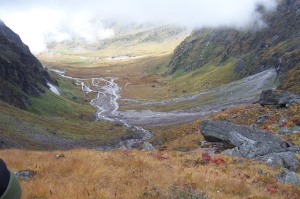 The first mile was gentle walk with only a bit tough crossing of Nandikund river. When we landed at vast field designed with web of countless streams, Umed showed us above at sky a point where we should climb. It was a straight wall like slope with boulders and grass fields separated in equal width. The fields were full of Brahmakamal and Umed warned us not to waste time in those patches. The place had a history of nauseating and intoxication for so abundance of those sacred flowers. The climb was pretty tough and last night’s rain had further aggravated it. It took us more than three hours to negotiate that steep climb of around 1500 mts.
The first mile was gentle walk with only a bit tough crossing of Nandikund river. When we landed at vast field designed with web of countless streams, Umed showed us above at sky a point where we should climb. It was a straight wall like slope with boulders and grass fields separated in equal width. The fields were full of Brahmakamal and Umed warned us not to waste time in those patches. The place had a history of nauseating and intoxication for so abundance of those sacred flowers. The climb was pretty tough and last night’s rain had further aggravated it. It took us more than three hours to negotiate that steep climb of around 1500 mts.  At the top, we decided to take right bank of river. Dinesh had, in the meanwhile, developed some signs of dizziness. He was advised to rush faster to Nandikund. The trail from the Nandikund top to Nandikund lake was more or less even although only boulders were there. But, there only we first noticed Phenkamal (popularly known as Vishnukamal), another sacred flower and rarest kind too. Entire space was full of those sparkling bubbles of violet jellyfish like flowers. It was absolutely heavenly ! At one point, we had to cross the river; but it was so beautifully laden over with rocky slabs that one might feel that it had been nicely laid by some PWD workers.
At the top, we decided to take right bank of river. Dinesh had, in the meanwhile, developed some signs of dizziness. He was advised to rush faster to Nandikund. The trail from the Nandikund top to Nandikund lake was more or less even although only boulders were there. But, there only we first noticed Phenkamal (popularly known as Vishnukamal), another sacred flower and rarest kind too. Entire space was full of those sparkling bubbles of violet jellyfish like flowers. It was absolutely heavenly ! At one point, we had to cross the river; but it was so beautifully laden over with rocky slabs that one might feel that it had been nicely laid by some PWD workers.  We could see now Nandikund peak just facing us and Gia Vinayak pass. Weather remained cloudy and we carefully jumped from one boulder to another. So close we had reached, yet we could not view the lake. It was surprisingly hidden until we did complete our last lap. Wow ! There was it—a turquoise half-circular lake deeply laid within cradle of all those mighty brown peaks! The lake was a full circle even a decade ago, but a glacial crash had taken half of it. It was so tranquil an environment! On one bank, there was a small rock-made temple of Devi Nanda. Some arms were kept there. People believe that those were some of those arms that great Pandavas had left there before final journey. The swords were so heavy that one would need both hands to even lift them. People say more are kept in some unknown caves around the place. Umed, our guide, took dip in freezing water. Lopa and he had not taken food also. We only splashed water on ourselves before pujas. We took hours there to enjoy its captivating beauty even under cloudy condition; walking along its bank, lying down in vast field of Phenkamal and Brahmakamal.
We could see now Nandikund peak just facing us and Gia Vinayak pass. Weather remained cloudy and we carefully jumped from one boulder to another. So close we had reached, yet we could not view the lake. It was surprisingly hidden until we did complete our last lap. Wow ! There was it—a turquoise half-circular lake deeply laid within cradle of all those mighty brown peaks! The lake was a full circle even a decade ago, but a glacial crash had taken half of it. It was so tranquil an environment! On one bank, there was a small rock-made temple of Devi Nanda. Some arms were kept there. People believe that those were some of those arms that great Pandavas had left there before final journey. The swords were so heavy that one would need both hands to even lift them. People say more are kept in some unknown caves around the place. Umed, our guide, took dip in freezing water. Lopa and he had not taken food also. We only splashed water on ourselves before pujas. We took hours there to enjoy its captivating beauty even under cloudy condition; walking along its bank, lying down in vast field of Phenkamal and Brahmakamal. 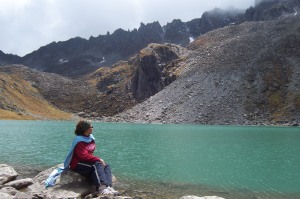 We had our lunch there too. It was already 1.30 pm and we decided for return journey. We thought descending would be much easier; but it was not that easy. We took lesser time to climb down, but with much of pain on finger tips. Finally when we reached back to Pandosera, it was almost 6 in the evening. Entire world had evaporated before us and it truncated to a miniature space of holding five humans and five horses, alone and away in utter wilderness of neither the earth nor the heaven !
We had our lunch there too. It was already 1.30 pm and we decided for return journey. We thought descending would be much easier; but it was not that easy. We took lesser time to climb down, but with much of pain on finger tips. Finally when we reached back to Pandosera, it was almost 6 in the evening. Entire world had evaporated before us and it truncated to a miniature space of holding five humans and five horses, alone and away in utter wilderness of neither the earth nor the heaven !
We were all happy to have finally completed our mission. We had overworked and needed rest soon. We took our dinner early with wishes for deeper slumber—fearing not bears or leopards anymore. But, the weather drastically improved within a few hours and we sat on—singing, clapping and enjoying a beautiful near full moon night. When we decided to sleep, it was already another day.
We woke up early too. We decided to cross Dwari and set our tents at Pavan Dwar. We had an early breakfast, quickly packed up and moved. Nearing Dwari top we saw some people coming from that side. Must be some trekkers! Yes, they were with guide Devendra, whom we had known for quite some time. The team was from Pauri—mainly hill people—attempting Kalpeswar via Nandikund. Devendra took some advice from Umed. By the time we had reached Dwari gud, it was not even noon. We decided to have our lunch first and then attempt that frightening climb. We spent not much time and made ourselves ready for the assault. We would be climbing along a different track. The crossing of river there was easier for two wooden logs were laid, side by side, and it was narrower too than the part we had crossed while coming. We crossed with balancing. But, facing the trail that Umed advised us avoid while descending, we felt it would not be either easier for climbing. I thought the trail we pursued earlier would have been easier for climbing too than it. 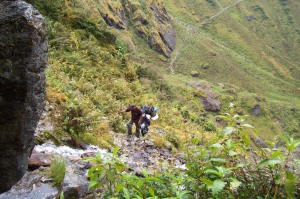 However, it would mean another nasty climb, again coming down and crossing of river before final assault. The path was as steep as it could be. Entire stretch had loose slippery grabbles and one side of it had straight fall. A deep fog had suddenly enveloped the surrounding. It truly troubled us. We slowly started climbing, some time, slipping and holding. It took us more than an hour to finally reach the top of the ridge. We would walk for another mile or so to reach Pavan Dwar. Two more ridges were there to cross. Sunny day had again showed up. We moved and moved on. We were much relieved to have crossed the most troubled part of our journey. By 5 pm we were safely in Pavan Dwar. Stretching limbs upon straw-laden shepherd’s place, we shared cherished moments of experience. We had a fantastic team which only contributed towards so much of joy. With the nightfall, dazzling moonshine illuminated the world.
However, it would mean another nasty climb, again coming down and crossing of river before final assault. The path was as steep as it could be. Entire stretch had loose slippery grabbles and one side of it had straight fall. A deep fog had suddenly enveloped the surrounding. It truly troubled us. We slowly started climbing, some time, slipping and holding. It took us more than an hour to finally reach the top of the ridge. We would walk for another mile or so to reach Pavan Dwar. Two more ridges were there to cross. Sunny day had again showed up. We moved and moved on. We were much relieved to have crossed the most troubled part of our journey. By 5 pm we were safely in Pavan Dwar. Stretching limbs upon straw-laden shepherd’s place, we shared cherished moments of experience. We had a fantastic team which only contributed towards so much of joy. With the nightfall, dazzling moonshine illuminated the world.  Amazing peaks shining with gentle blue glow and deep dark sky draped in an exquisite veil of stars and planets had transformed entire atmosphere into a surreal one. We spent our night mostly outside the tents fighting a biting cold.
Amazing peaks shining with gentle blue glow and deep dark sky draped in an exquisite veil of stars and planets had transformed entire atmosphere into a surreal one. We spent our night mostly outside the tents fighting a biting cold.
The morning welcomed us with absolutely bright sky. We moved to Nanda Berari according to set plans for that night. Water was a major problem there for the pool that we had used while going towards Dwari dried up. It took two hours to fetch it. It was fiercely cold in the night also. We decided to creep into tents soon.
It was a clear weather and the descent was easy and short. By the noon, we reached Madmaheswar. We spent gossiping over our trip with known people and Pujariji. Long trek had already made us a bit tired.
We set for Buda Madmaheswar early at 5.30 am on the next morning. We reached there before the sun had risen above majestic Chowkhamba. 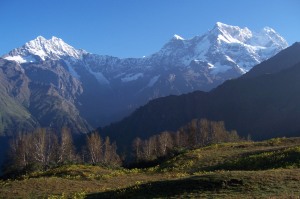 Azure sky, snow-white Mandani and Chowkhamba accompanied by Bhuj trees in front were all set a perfect stage for a grand sunrise. With not much of wind, water of all those three small lakes stood still and clear. Lopa went on clicking. Last time she missed a bright weather here. After long hours over there, we climbed down to Madmaheswar. It would be another long trek, so we had our breakfast and packed up for final descent. By the evening, we reached Ransi. Rakeswari Mela had started and we enjoyed being there. We brought lots of Brahmakamal and Phenkamal that we shared with everyone for pujas. We felt that we had come back home.
Azure sky, snow-white Mandani and Chowkhamba accompanied by Bhuj trees in front were all set a perfect stage for a grand sunrise. With not much of wind, water of all those three small lakes stood still and clear. Lopa went on clicking. Last time she missed a bright weather here. After long hours over there, we climbed down to Madmaheswar. It would be another long trek, so we had our breakfast and packed up for final descent. By the evening, we reached Ransi. Rakeswari Mela had started and we enjoyed being there. We brought lots of Brahmakamal and Phenkamal that we shared with everyone for pujas. We felt that we had come back home.
We woke up a bit late in the morning. The eyes of Dinesh were already filled with tears. He wished to come along with Umed to bid us adieu. Umed Negi also joined. We came out of Umed’s home; so many known and unknown faces gathered. We did not know how and when deep relationship had silently taken birth, grown and now it yearned to flourish through trusting eyes and simple wishes. We walked on, again the five men army, now towards a finality; to board Rudraprayag bound bus from Uniana.
I dedicate this travelogue to those three men who succeeded in making us a team. Success never turns towards reaching a destination, it only opens up newer windows of knowing innerself.
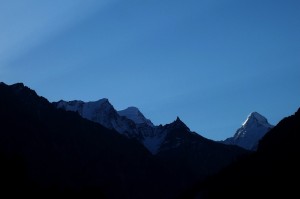

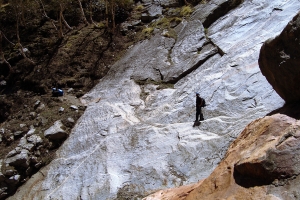
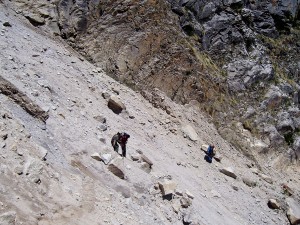
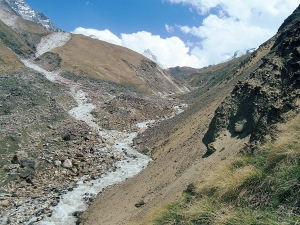
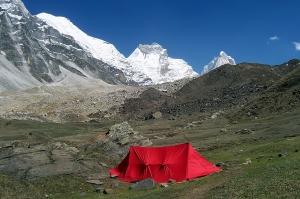


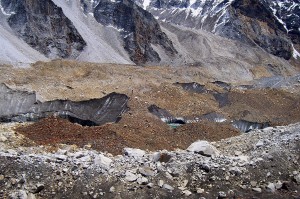
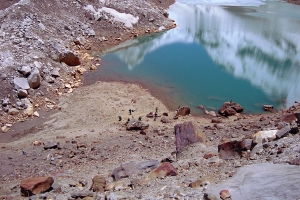
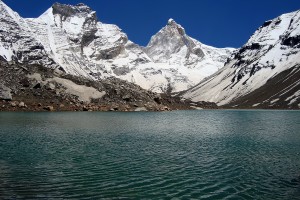
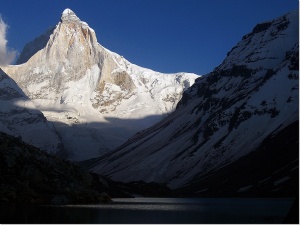
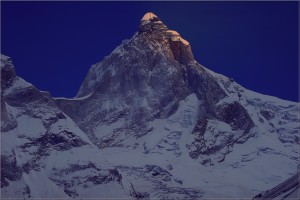
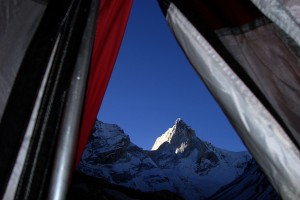

















Recent Comments